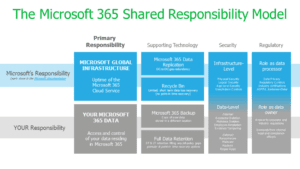Understanding Microsoft 365’s Shared Responsibility Model: Safeguarding Your Data Together
August 7, 2023
Back To NewsUnderstanding Microsoft 365 Shared Responsibility Model: Safeguarding Your Data Together
In the digital age, businesses and organisations rely heavily on cloud services to streamline their operations and enhance collaboration. Microsoft 365, a powerful suite of cloud-based productivity tools, has become a cornerstone for countless enterprises worldwide. However, as the volume of critical data stored in the cloud continues to surge, ensuring its security and compliance becomes paramount.
To address this concern, Microsoft has implemented a shared responsibility model, designed to distribute security and compliance responsibilities between the tech giant and its customers. In this blog post, we will delve into the intricacies of the Microsoft 365 Shared Responsibility Model and explore the vital role it plays in safeguarding your data.

1. What is the Microsoft 365 Shared Responsibility Model?
The Microsoft 365 Shared Responsibility Model represents a collaborative approach to protecting data stored and processed within Microsoft’s cloud infrastructure. By dividing responsibilities between Microsoft and its customers, the model establishes a clear framework for maintaining the security and compliance of the platform.
2. Microsoft’s Responsibilities:
At the foundation of this model lies Microsoft’s commitment to the security and integrity of their cloud services. The responsibilities held by Microsoft include:
- Infrastructure Security: Safeguarding the physical data centers, networking equipment, and hardware that support the Microsoft 365 services.
- Platform Security: Ensuring the security of the underlying platform and its components, including continuous monitoring and threat detection.
- Application Security: Securing the core Microsoft 365 applications, such as Exchange Online, SharePoint Online, and OneDrive for Business, against potential vulnerabilities.
- Regular Updates: Regularly releasing security updates and patches to keep the platform resilient against emerging threats.
3. Customer’s Responsibilities:
While Microsoft shoulders the foundational security aspects, customers play an equally vital role in safeguarding their data within the Microsoft 365 environment. The responsibilities of customers encompass:
- Data Access and Usage: Managing user access, permissions, and roles to control who can access specific data and services within the Microsoft 365 suite.
- Data Management: Taking charge of data creation, modification, and deletion while ensuring proper organisation and categorisation.
- Compliance: Adhering to industry-specific regulations and standards relevant to the organisation and configuring Microsoft 365 to meet compliance requirements.
- Data Protection: Implementing additional measures to protect data from accidental deletion, data leakage, or other data-related risks.
- Endpoint Security: Ensuring that devices used to access Microsoft 365 services are protected with robust endpoint security measures.
4. The Importance of Understanding the Shared Responsibility Model:
Understanding the shared responsibility model is essential for organisations as it provides a holistic view of the security and compliance measures required to protect sensitive data effectively. This awareness empowers businesses to implement appropriate security controls and reduce the risk of data breaches.
5. Embracing a Secure Microsoft 365 Environment:
To create a secure Microsoft 365 environment, organisations should:
- Stay Informed: Regularly review updates and announcements from Microsoft regarding security best practices and new features.
- Educate Users: Educate employees about data security best practices and their roles in protecting sensitive information.
- Implement Advanced Security Measures: Utilise Microsoft 365’s built-in security features and consider additional security tools when needed.
The Microsoft 365 Shared Responsibility Model offers a robust approach to securing cloud-based data, combining the expertise of Microsoft with the diligence of organisations using the platform. By understanding and embracing this model, businesses can confidently utilise Microsoft 365 to streamline operations, collaborate effectively, and protect their valuable data from evolving cyber threats. Together, we can create a safer and more resilient cloud environment for everyone.